Pension Index Cards – 177th Pennsylvania Infantry, Company I
Posted By Norman Gasbarro on October 20, 2011
Pension Index Cards, as previously mentioned and pictured on this blog, are references to the collection of original records of pension applications which are stored at the National Archives in Washington, D.C. The database, officially entitled “Civil War Pension Index: General Index to Pension Files, 1861-1934,” is available through Ancestry.com. The description of the database, as provided by Ancestry.com, is as follows:
One of the defining events in American history, the Civil War involved millions of men who served the United States and the Confederate States. Millions of these men, or their dependents, applied for pension support from the federal government. These application cards (for Federal, not Confederate pensions) were indexed by the Pension Office and kept by the National Archives. This database is an index to nearly 2.5 million of these application cards. Each record includes the veteran’s name and state in which he, or his dependents, filed the application. If a widow or a child filed the application, their name is provided. Because these pension files were for federal benefits, this collection only contains the names of Union veterans. To researchers of Civil War ancestors this database can be a useful source of detailed information. In addition, the index contains a link to a digitized image of the index card itself, which will contain additional information on the individual, such as unit of service, date of filing, and application and certificate numbers for the pension case file housed at the National Archives and Records Administration in Washington D.C…..
After locating an entry in the Civil War Pension Index, researchers may follow the Images Online link to a scanned image of the index card itself. This index card contains the name of the Civil War soldier (occasionally listed with alias) and the names of any dependants such as a widow, child, etc. Also listed in the service section of the card will be the unit or units where the soldier served, usually abbreviated (“cav” for cavalry, “inf” for infantry, “vol” for volunteer, and so on). The bottom half of the card will list dates of filing and certificate numbers, which researchers will use if they request the full casefile from the National Archives and Records Administration.
Occasionally index cards will have a slightly different layout as the nature of the service dictated that different information be recorded.
After locating an ancestor in the Civil War Pension Index, researchers are urged to request a copy of the case file referred to by the index.
According to the National Archives, “…the number and type of documents in the Civil War and later series vary greatly from file to file; they are often numerous. The documents of greatest genealogical interest include the declaration of the veteran, the declaration of the widow, the statement of service from the War or Navy Department, the personal history questionnaire, and documents relating to the termination of pensions.”
The Pension Index Cards themselves are a much useful reference and have been used on this blog to help separate multiple veterans with the same name, determine the names of wives and widows, to estimate the death date of the veteran, to determine other regiments in which the veteran served, and to locate post-war residences of veterans who moved out-of-state.
Because the pension laws were frequently changed to become more liberal on who was eligible, veterans often applied multiple times in order to receive their first pension and in order to receive increases they felt were due to them. An army of lawyers besieged the overburdened Pension Office throughout its existence – working on behalf of the veterans as well as themselves. Medical doctors had to testify as to the veterans illnesses and the files contain a virtual catalog of every conceivable disease known in the nineteenth century.
Prior to 1890, it was very difficult for a veteran to get a pension for disability, unless that disability were directly related to an injury or loss that was directly battle-related. Many of these early pension application contain stories of heroic (or sometimes not so heroic) deeds. Sworn statements by colleagues who shared the same battle experience and who spent time in some of the worst Confederate prisons are also found in the pension files.
From 1890 onward, it was relatively easy for any veteran who had survived that long after the war to receive compensation for service. Likewise, widows of veterans, if their husbands had received a pension, received continuations of their husband’s pension. All they had to do was prove that they were legally married to the veteran and that there were no other wives around to make counter claims. Therefore, the pension files contain many nineteenth century affidavits of marriage, sworn to by witnesses or by clergymen who had carefully kept records of the activities of their charge. Records of children born to the couple are also found within the pension applications. On a regular basis, the veteran was required to submit updates with the names and birth dates of living children.
According to the National Archives:
…the number and type of documents in the Civil War and later series vary greatly from file to file; they are often numerous. The documents of greatest genealogical interest include the declaration of the veteran, the declaration of the widow, the statement of service from the War or Navy Department, the personal history questionnaire, and documents relating to the termination of pensions.
While the database suggests actual acquisition of the case file, it is not the purpose of this blog post to explain how that can be done. Rather, it is the purpose of this post to show what information can be gleaned from the Pension Index Card itself.
The 177th Pennsylvania Infantry, Company I,was a drafted militia that served for nine months. No member of this militia was reported injured as a result of a military act, so, theoretically, nearly all the pension applications should be post-1890, when “age” became the most significant factor for the veteran to receive a pension. This should be reflected in the date of application on the Pension Index Card. If the veteran died before 1890, there probably was no application made by the veteran, but it is possible that a widow applied. In the column for “Certificate Number,” if no number appears, this would indicate that an application was made, but no pension was awarded. If a number appears in the “Certificate Number” column, it can be assumed that a pension was awarded, although the date of the award cannot be determined from the Pension Index Card.
Finally, some of the Pension Index Cards were poorly microfilmed and the dates on the card are difficult to read. Ancestry.com has recognized this problem and indicates that these cards will be re-microfilmed if the originals are still available.
For each of the veterans who served a full term in the 177th Pennsylvania Infantry, Company I, a Veteran’s Index Card from the Pennsylvania Archives will be shown, followed by the Pension Index Card for that individual, if available. In no particular order of veterans, the analysis begins below and will continue in subsequent posts until all the remaining veterans are listed.
——————————
LAWRENCE BOYER (1835-1920). Draftee from Dauphin County, Pennsylvania. Mustered in as a Corporal by Capt. Norton, 2 November 1862. Mustered out with company, 5 August 1863.
From the Pension Index Card, it is determined that Lawrence had service only with the 177th Pennsylvania Infantry. He had a widow named Phebe and both he and the widow applied for pensions from outside the state of Pennsylvania – Lawrence from Kansas and Phebe from Washington State. A search of the census records locates him in the 1885 Kansas census as a farmer and stock man, but by 1890, he is in Washington State for the Veterans’ Census. Previous and subsequent census records fall into place and he is discovered with origins in Orwigsburg, Schuylkill County through his death in Washington State – with a “westward movement” stop in Iowa in 1870. A picture of him is also found, posted by an Ancestry.com. member. While no specific reference to he Lykens Valley area has yet been found, the search for information about him has been helpful in that his service in the Civil War was under Captain Benjamin Evitts, who was one of the significant leaders thus far identified for the Civil War Research Project of the Gratz Historical Society.
FREDERICK A. HAINES. Draftee from Dauphin County, Pennsylvania. Mustered in as a Private by Lt. Fetterman, 2 November 1862. Discharged on Surgeon’s Certificate of Disability on 2 November 1862.
For Frederick Haines, no Veterans’ Index Card has been located, although the roll of the 177th Pennsylvania Infantry shows that he was discharged on2 November 1862 on a Surgeon’s Certificate of Disability. Why then is there a Pension Index Card? Here is a case that needs further examination. The card indicates that a widow, Mary A. Haines, applied for a pension in 1892, based on her husband’s “service in the 177th Pennsylvania Infantry, but she did not receive a pension – as noted by the lack of the certificate number on the card! The application date appears to be 9 Jun 1892, which would probably lead to the conclusion that Frederick died about that time. A search of the census of 1890 produced no good matching result, although it could be assumed that Frederick was still alive if the widow did not apply until 1892. This is a case where the actual pension file will have to be consulted to determine what actually transpired.
——————————
ABRAHAM SNYDER (1844-1905). Draftee from Dauphin County, Pennsylvania. Mustered in as a Private by Capt. Norton, 2 November 1862. Mustered out with company, 5 August 1863. Later enlisted in the 9th Pennsylvania Cavalry. Mustered in 16 February 1864, unassigned to a company, and was later not accounted for.
For Abraham Snyder, the Pension Index card provides the information that Snyder had service with the 9th Pennsylvania Cavalry – both unassigned and Company B. A search of the Pennsylvania Archives Veterans’ Index Cards does produce a card for him as follows:
From the card, it is clear that he was mustered into the 9th Pennsylvania Cavalry on 16 February 1864 and mustered out on 18 July 1865. However, other records indicate that he was unaccounted for at muster out. The curiosity here is that Abraham Snyder‘ did not apply for a pension and when his widow Amelia Snyder applied, she did not receive a pension. There is no indication that his service in the 177th Pennsylvania Infantry was anything but honorable. However, there is some confusion in the records as to his departure from the 9th Pennsylvania Infantry. Again, the question of why he did not apply for a pension and why his widow applied but did not receive one can probably be answered by consulting the actual pension file at the National Archives.
Curiously also, no good matches have been found for Abraham Snyder in the 1890 Veterans’ Census. If he was still alive in 1890, how did he evade the census? There is also no connection yet found which would associate Abraham Snyder with the Lykens Valley area and the Civil War Research Project.
——————————–
ISRAEL H. REED (1838-1895). Draftee from Dauphin County, Pennsylvania, but records indicate he was born in Hegins, Schuylkill County. Mustered in as a Private by Capt. Norton, 2 November 1862. Mustered out with company, 5 August 1865. Later enlisted in the 192nd Pennsylvania Infantry, 21 February 1865. Served until mustered out with company on 24 August 1865.
The Pension Index Card confirms the information that Israel Reed served in the 192nd Pennsylvania Infantry but also gives the clue that he applied for his pension from Nebraska. Searching the census, Israel Reed is found in the 1890 Veterans’ Census for Boone County, Nebraska. Backing up to the 1880 Census, he is also found in Boone County along with wife Caroline. This information is matched with information in other family trees and with other sources on Ancestry.com and it is quickly discovered that Israel Reed was married to Caroline Shoop – and that Israel was born in Hegins, Schuylkill County. Birth in Hegins qualifies Israel Reed for inclusion in the Civil War Research Project. Both Israel and his widow received pensions, so the file at the National Archives should be quite extensive.
————————————
Thus, it is shown with these few examples, there is great usefulness in the Pension Index Cards. They don’t supply all the information needed but they often supply enough information to find other key facts in identifying the veteran and his family. Future posts on the 177th Pennsylvania Infantry, Company I, will follow the same format until all of the veterans are presented.
Pennsylvania Veterans’ Index Cards are from the Pennsylvania Archives. The roll of the 177th Pennsyvlania Infantry, Company I, is also available at the Pennsylvania Archives: page 1; Company I, page 2; Company I, page 3; and Company I, page 4. Benjamin J. Evitts of Lykens Township and Gratz Borough was Captain of Company I. Prior posts on Benjamin J. Evitts can be located by clicking on the tag, “Evitts Family.” For prior posts on the 177th Pennsylvania Infantry, click here.
The Civil War Research Project is seeking more information on the draftees of Company I, 177th Pennsylvania Infantry, particularly those from Dauphin County. The men named above may not have previously been included in the Civil War Research Project, but if they have a geographic connection to the Lykens Valley area, they should be included. Contributions are welcome from readers!
 ;
;
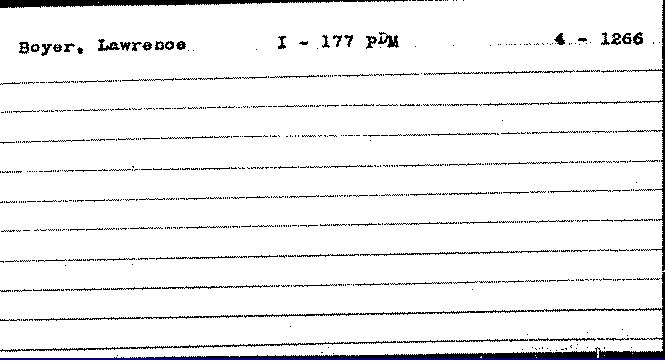

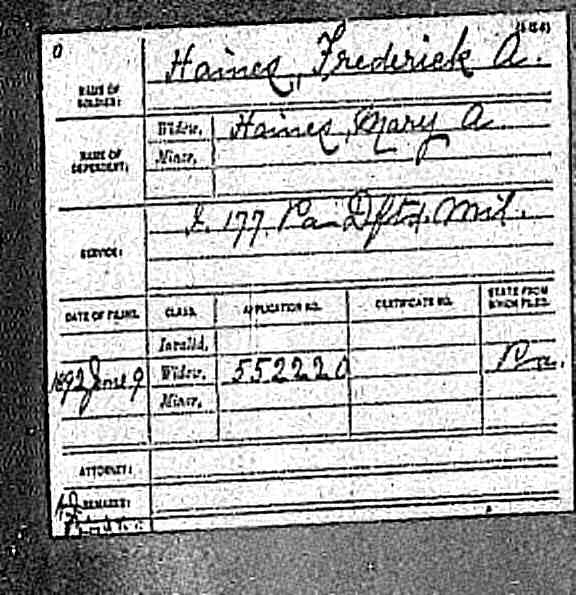

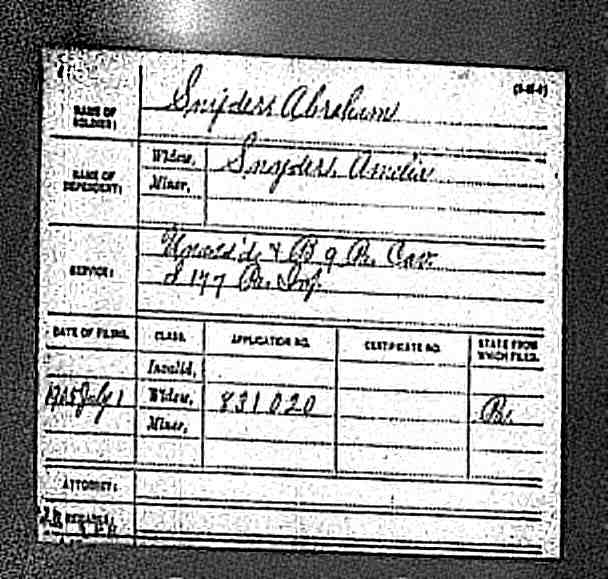
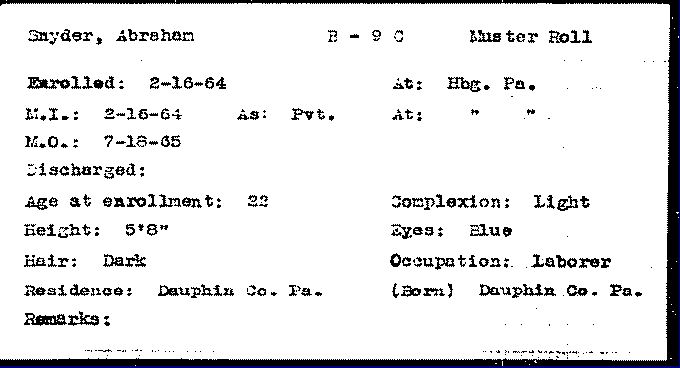
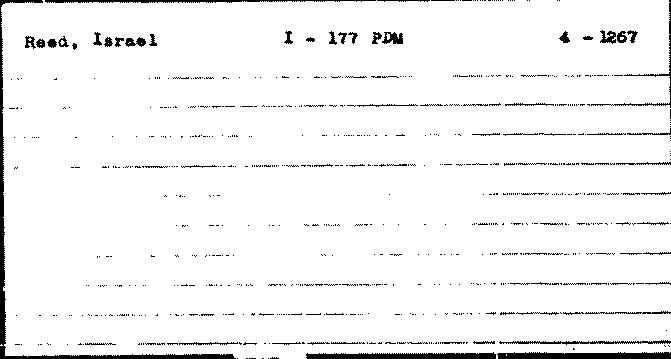
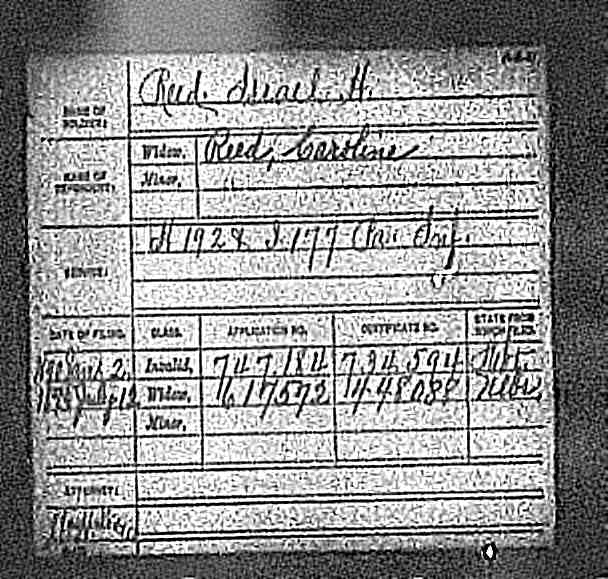


Comments